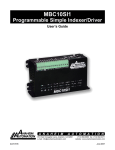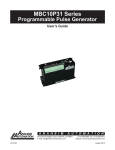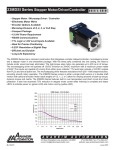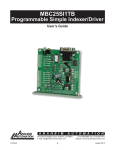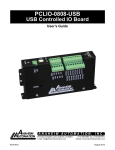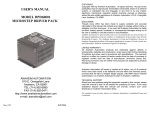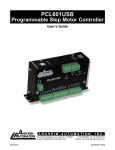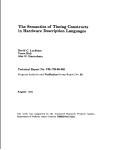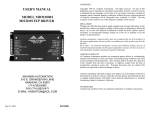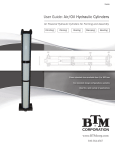Download Anaheim Automation PROGRAMMABLE SIMPLE INDEXER/DRIVER MBC10SI1 User`s guide
Transcript
MBC10SI1 Programmable Simple Indexer/Driver User’s Guide A N A H E I M A U T O M A T I O N 910 East Orangefair Lane, Anaheim, CA 92801 e-mail: [email protected] L010185 1 (714) 992-6990 fax: (714) 992-0471 website: www.anaheimautomation.com August 2012 MBC10SI1 Features • Output Current of 10.0A Peak • 2000 Steps/Revolution • On-Board Programmable Simple Indexer with 2 Motion Profiles • Pulses From 1Hz to 50kHz • Directional Soft and Hard Limit Switch Inputs • Complete Output • Busy Output • Motor On/Off Input and Automatic Current Reduction • Short Circuit Protection General Description The MBC10SI1 is a low cost single axis step motor driver integrated with a programmable simple indexer. The MBC10SI1 microstep driver/pulse generator has an output current capability of 1.5A minimum to 10.0A maximum (peak rating). The MBC10SI1 driver operates with a DC voltage of 20VDC to 80VDC. The MBC10SI1’s internal controller has two different programmable motion profiles. The MBC10SI1 also has directional soft and hard limit switch inputs, a busy output and a complete output letting the user know when an inded is finished. The MBC10SI1 driver features direction control and motor current On/Off capabilities. The “Reduce Current Enabled” feature automatically reduces motor current to 50% of the set value. The driver has built in features to indicate power on (green LED), running (yellow LED) and error conditions (red LED). The MBC10SI1 has a fixed step resolution of 2000 steps/revolution for a 1.8° stepper motor. The bipolar drive configuration handles 4, 6, and 8 lead step motors and is also equipped with over current protection. The MBC10SI1 communicates via USB communication. The easy to use Windows software, SMPG-SMSI Software, is used to directly set up the two different motion profiles. Motion Profiles and Running the Indexer The programmable simple indexer has the ability to store up to two different motion profiles. The profiles include a base speed (starting speed), a maximum speeds (running speed) acceleration/ deceleration, the number of steps (index) and a complete time (output signal). The base speed has a range of 1-5000Hz, the maximum speed has a range of 1 Hz-50 kHz and the acceleration/ deceleration has a range of 100 to 9,999,999 steps/sec2 and the index has a range of 0-8,388,607 steps and the complete time has a range of 1-1000 milliseconds. There are “two ways” to get the unit to index: Examples are shown on the next page. 1. The first way is to directly control it from the computer with the software provided. Once the motion profiles have been set, the unit is ready to run. From the software, the user can select which profile to run and then click the begin motion button. If a soft limit command is sent or a soft limit input is activated, then the unit will immediately ramp down to base speed and stop. To stop motion immediately a hard limit command needs to be sent or a hard limit input must be activated. 2. The second way to make the unit run is to activate the individual index input. When an index input is activated, it selects from memory the speed profile that was selected. If a soft limit input is activated, then the unit will immediately ramp down to base speed and continue running until the index has completed. To stop all motion before the index has completed a hard limit input must be activated. L010185 2 August 2012 Motion Profiles and Running the Indexer: Continued Normal Operation A. B. C. D. A Profile input is activated; Ramps up to max speed. No limit is active; Max speed is reached (keeps running at max speed). No Limit is active; Internal counter signals to ramp down to base speed. Internal Counter is complete; Base speed is reached. Pulses stop. Soft Limit Activated During Index A. A Profile input is activated; Ramps up to max speed. B. No limit is active; Max speed is reached (keeps running at max speed). C. Soft limit is activated; Ramp down to base speed. D. Base speed is reached; Continue until counter is complete. E. Internal Counter is complete; Pulses stop. Hard Limit Activated During Index A. A Profile input is activated; ramps up to max speed. B. No limit is active; Max speed is reached (keeps running at max speed). C. Hard limit is activated; Pulses stop (Index did not complete). L010185 3 August 2012 LEDs When powered and operated properly, the status LED will be green. When a communication or program syntax error occurs, the LED will change to RED and an error code will be generated in the error code register. To read and clear the error with the software, click on the “Verify Parameters” button. To read and clear the error while in “Direct Mode” use the “!” command. Once the error has been read and cleared, the LED will return to green and the error code register will be cleared. Refer to the table in the trouble-shooting section for a list of the error codes. When the indexer is running the yellow LED will be on. Refer to the dimension drawing for location of the LEDs. For more detail on “Direct Mode” Refer to the Direct Talk Mode Section of User’s Guide. Baud Rates A term used frequently in serial data communications. A “baud” is defined as the reciprocal of the shortest pulse duration in a data word signal, including start, stop, and parity bits. This is often taken to mean the same as “bits per second”, a term that expresses only the number of “data” bits per second. Very often, the parity bit is included as an information or data bit. The MBC10SI1 only accepts a baud rate of 38400. Inputs and Outputs Inputs: All inputs are pulled up to 5VDC. A logic “0” activates inputs that are pulled up. An unconnected input will always remain inactive. Direction: When this input is not active, the motor will be moving in the clockwise or “+” direction. When this input is active, the motor will move in the counterclockwise or “-” direction. This input is not read when a software index command is given. To change direction while using the software, change the direction option there. When two motors are used, the second motor will move in the opposite direction by default. On/Off: When this input is not active, the motor will enabled or energized. When this input is active, the motor will be disabled or de-energized. Index 1 and 2: These inputs are used to select on of the two profiles. When one of the profiles is activated, the unit will change the speeds, acceleration and index number based on the pre-programmed values for that profile and begin the index. Activate only one of these two inputs at once. Soft Limits: These two inputs are controlled by the direction of the indexer. When the indexer is running in the positive direction only soft+ will work. When the indexer is running in the negative direction then only soft- will work. When pulled low the motor will ramp down to base speed and continue running until the index is completed or a hard limit is reached. Hard Limits: These two inputs are controlled by the direction of the indexer. When the indexer is running in the positive direction only hard+ will work. When the indexer is running in the negative direction then only hard- will work. When pulled low the indexer will stop all pulses to the motor. To reverse off of a Hard Limit, change directions, and activate another profile input again to move in the opposite direction. Complete Output: This is an open collector output that is capable of sinking 10mA. It is current sinking when the indexer completes its motion and is only active for the pre-programmed time. Busy Output: This is an open collector output that is capable of sinking 10mA. It is current sinking when the indexer is running and open when the indexer is not running. L010185 4 August 2012 Connector Descriptions Connector P2: Pin # Description L010185 1 Power Supply Ground (0VDC) 2 Power Supply Input (20VDC - 80VDC) 3 Motor Phase 1 (A) 4 Motor Phase 3 (/A) 5 Motor Phase 2 (B) 6 Motor Phase 4 (/B) 7 Index 1 8 Index 2 9 Motor On/Off 10 Direction In 11 Busy Output 12 Complete Output 13 Soft Limit + 14 Soft Limit - 15 Hard Limit + 16 Hard Limit - 5 August 2012 Ordering Information Part Number Description MBC10SI1 10.0A Microstep Driver with Integrated Programmable Simple Indexer PSA80V4A Power Supply for MBC10SI1 (80V @ 4.0A) AAUSB-6 6 foot USB communication cable, A-Male to B-Male Specifications Voltage Requirements: Run Input (P2, Pin 5,6,7 and 8): Direction Input (Pin): On/Off Input (Pin): Start Low (0VDC) CW High (Open) CWW Low (0VDC) On High (Open) Off Low (0VDC) Busy Output (Pin): Open Drain type Output, 75mA Sink, 40VDC Stand Off Clock Output (Pin 1): Open Drain type Output, 75mA Sink, 40VDC Stand Off Clock Out Frequency (P3, Pin 1): Output Current: TA=25°C Driver Chopping Frequency: Operating Temperature: LEDs Com Port Settings: L010185 20 - 80 VDC Min 1 Hz Max 50kHz Min 0.5A peak Max 10.3A peak 25kHz - 30kHz 0° - 70° C Green Power On Red Programming Error Yellow Pulse Generator is busy 115200,N,8,1 6 August 2012 Dimensions Wiring Diagrams L010185 7 August 2012 Setting the Output Current The output current on the MBC10SI1 is set by the on-board potentiometer R29 (Refer to Dimensions/Jumper and Potentiometer Locations). This current adjust potentiometer determines the per phase peak output current of the driver. This relationship between the output current and the potentiometer setting is as follows: Potentiometer Settings Peak Current Potentiometer Setting 1.5A 0% 2.4A 10% 3.0A 20% 4.0A 30% 5.2A 40% 6.4A 50% 7.7A 60% 8.7A 70% 9.8A 80% 10.0A 90% 10.3A 100% Reducing Output Current Reducing the output current is accomplished automatically depending on the current reduction setting in the SMPG-SMSI software. The amount of current per phase in the reduction mode is approximately 70% of the set current. When the current reduction circuit is activated, the current reduction resistor is paralleled with the current adjustment potentiometer. This lowers the total resistance value, and thus lowers the per phase output current. This is done when the pulse generator is not running. L010185 8 August 2012 Determine Output Current The output current used for motor when microstepping is determined differently from that of a full/half step unipolar driver. In the MBC10SI1, a sine/cosine output function is used in rotating the motor. The output current for a given motor is determined by the motors current rating and the wiring configuration of the motor. There is a current adjustment potentiometer used to set the output current of the MBC10SI1. This sets the peak output current of the sine/cosine waves. The specified motor current (which is the unipolar value) is multiplied by a factor of 1.0, 1.4, or 2.0 depending on the motor configuration (series, half-coil, or parallel). Step Motor Configurations Step motors can be configured as 4, 6, or 8 leads. Each configuration requires different currents. Refer to the lead configurations and the procedures to determine their output current. WARNING! Step motors will run hot even when configured correctly. Damage may occur to the motor if a higher than specified current is used. Most specified motor currents are maximum values. Care should be taken to not exceed these ratings. 6 Lead Motors When configuring a 6 lead motor in a half-coil configuration (connected from one end of the coil to the center tap), multiply the specified per phase (or unipolar) current rating by 1.4 to determine the current setting potentiometer value. This configuration will provide more torque at higher speeds when compared to the series configuration. When configuring the motor in a series configuration (connected from end to end with the center tap floating) use the specified per phase (or unipolar) current rating to determine the current setting potentiometer value. 4 Lead Motors Multiply the specified series motor current by 1.4 to determine the current adjustment potentiometer value. 4 lead motors are usually rated with their appropriate series current, as opposed to the Phase Current, which is the rating for 6 and 8 lead motors. L010185 9 August 2012 8 Lead Motors Series Connection: When configuring the motor windings in series, use the per phase (or unipolar) current rating to determine the current setting potentiometer value. Parallel Connection: When configuring the motor windings in parallel, multiply the per phase (or unipolar) current rating by 2.0 to determine the current setting potentiometer value. Note: After the current has been determined, according to the motor connections above, use the potentiometer setting table to choose the proper setting for the current setting potentiometer. Connecting the Step Motor The MBC10SI1 is designed to accept one motor. For wiring of the motor refer to the pages containing the connector descriptions and hookups diagrams. The motor is wired into pins 3, 4, 5 and 6 of the terminal block. Note: The physical direction of the motor with respect to the direction input will depend on the connection of the motor windings. To reverse the direction of the motor with respect to the direction input, switch the wires on phase 1 and phase 3. With the operation of 2 motors, they will run in the opposite direction when wired the same. WARNING: Do not connect or disconnect motor wires while power is applied! Circuit Protection This driver is equipped with over current protection. Note: When drive experiences a fault condition, it will seize to function. Power down, inspect wiring, motors, etc. and allow for a 30 second pause to resume functioning. If driver is too hot, additional ventilation and airflow should be added to prevent temperature to exceed recommended temperature limit. L010185 10 August 2012 Functions Hard Limit Switches: When a hard limit switch is encountered, the pulses will stop. Hard limits are intended as an emergency stop for your system. Soft Limit Switches: These switches cause the indexer to ramp down to the base speed and finish the index, unless encountering a hard limit switch. Profile Inputs: These inputs are used to select and begin the specified motion profile. Only 1 input should be activated at a time. Motion Profiles: The indexer will accept two different speed or motion profiles. Each profile has its own programmable Accel/Decel, Base speed and distance value. These values are stored in EEProm for standalone use and must be programmed before the indexer is ran. Acceleration/Deceleration: The acceleration and deceleration are by default the same value. This function controls the time that the motor will take to move from base speed to max speed. The higher the value, the slower the motor will accelerate. The same principle applies for the deceleration which is controlling the time it takes to go from maximum speed to base speed. The higher the value, the slower the pulses will decelerate. The different accel/decel profiles are stored in EEprom for standalone use. (Range: 100 to 9,999,999) Base Speed: The base speed is the speed at which motion starts and stops. It is entered directly as the number of steps per second. This speed must always be less than the max speed. The different base profiles are stored in EEprom for standalone use. (Range:1 to 5000) Max Speed: The max speed is the top speed the user wants the pulses to run at. This speed must always be equal or greater than the base speed. It is entered directly as the number of steps/second. The different max profiles are stored in EEprom for standalone use. (Range:1 to 50,000) Index Number: The index number is the number of steps that the motor will take when the motion profile starts. It is entered directly as the number of steps to take. The different index profiles are stored in EEprom for standalone use. (Range: 0 to 8,388,607) Complete Time: The complete time is the duration that the complete output is held after an index has completed. This number is entered in the number of milliseconds that the output is to be held low. Direction Input: If this input is open then the unit will be running in the clockwise direction. If this input is active then the unit will be running in the counterclockwise direction. This pin can be overridden by the programmable software direction. It will activate the direction output when the pin is changed. This means, that if you start the profile from the software, the unit will look at the software direction. If you start the indexer from the inputs, then the unit will look at the direction input. Busy Input: This output will be pulled low when the indexer is operating. It is an open drain output so when the indexer is not running the pin is open. Complete Output: This output will be pulled low after the indexer is done indexing for the duration given in the complete time parameter. It is an open drain output so when the output is not active the pin is open. It is entered directly as the number of milliseconds the output will be active for. The different complete time profiles are stored in EEProm for standalone use. (Range:1 to 1000) L010185 11 August 2012 SMPG-SMSI Software The SMPG-SMSI software is a handy utility that supports Anaheim Automation’s programmable pulse generators and simple indexers. Connecting your PC to the MBC10SI1, via a serial cable, the software can easily perform the following tasks: • Exercise and monitor the MBC10SI1 • Directly communicate with the MBC10SI1 Installation Software • The SMPG-SMSI software is supplied on a CD, containing the setup program and the software. • SMPG-SMSI software is compatible with all versions of Windows including Windows 2000, Windows XP, Vista, and Windows 7 Windows 3.x Installation 1. Insert the CD into the drive 2. From the Program Manage select File │ Run 3. Enter D:\setup and click OK - use the appropriate drive letter (i.e. D or E) Windows 95/98/NT/ME/2000/XP Installation Option 1 1. Insert the CD into the drive 2. From the Program Manager select Start │ Run 3. Enter D:\setup and click OK - use the appropriate drive letter (i.e. D or E) Option 2 1. Open Windows Explorer 2. Open CD Drive Folder (D: or E:) 3. Double Click the setup Icon Getting Started 1. Double click on the SMPG-SMSI icon to run the software. 2. Apply power to the MBC10SI1 unit. 3. Set the appropriate communication setting by selecting Setup │ Communication Setting from the menu bar. 4. Establish communications with the MBC10SI1 by clicking on the Connect Icon, or select Setup│Connect. If the unit is connected properly, the program will notify you when communication has been established and the correct programming tab will be enabled to let you work with the unit Changing the COM Port Number of the USB port 1. From DeviceManager, select “View devices by type”, then “Ports (COM & LPT)”. Select the USB serial port and click Properties. Select the “Port Settings” tab, then click Advanced. 2. Choose the required COM port number from the list and click OK. L010185 12 August 2012 “The Unit is Connected” / “The Unit is Not Connected” On the right of the Toolbar, the user will find the communication status of the indexer. If communications is not established, please refer to the troubleshooting section. File Menu Setup Menu Exit Connect Disconnect Exit the SMPG10WIN Software Establish communications with the controller. Discontinue communications and release the comport for use by other devices. Communication Settings... COM port Selection (Ports 1, 2, 3, 4, 5, 6 or 7) Toolbar Exit Connect L010185 Exit the SMPG-SMSI Software Establish communications with the controller. 13 August 2012 Program Window Motion Profile Select motion profiles 1, or 2. Send Accel/Decel Send the acceleration & deceleration parameter to the indexer. (steps/sec2) Send Base Spend Send the base speed parameter to the indexer. (steps/sec) Send Max Speed Send Index Number Begin Motion Send the maximum speed parameter to the indexer. (steps/sec) Send the index number parameter to the indexer. (steps) Motor will ramp up to maximum speed and keep moving until a limit switch is triggered or the index is complete. Soft Limit Motor will ramp down to base speed and continue running until the index is complete. Hard Limit Stop any motor motion. Direction Set direction to clockwise or counter-clockwise. Reduced Current Set reduced current on or off. Verify Parameters Updates and displays controllers parameters and resets the error codes. L010185 14 August 2012 Direct Talk Mode Direct mode is used to directly control the motion for real time movements through serial communication. The indexer has 14 commands which are easy to remember for direct movement of a step motor. COM Port Settings Baud Rate: 115200 Parity: None Data Bits: 8 Stop Bits: 1 Flow Control: Xon/Xoff Unit Selection In order to select a unit the @ command followed by 0 (address of the unit) must be sent. NOTE: There should be no spaces between the @ and the 0. How to select the unit: @0 (Unit is selected) How to get a response from the unit: @0$ (Carriage Return) After the $ command, the pulse generator will return a SMSI20 + the current version number. Note: In direct talk mode each command is followed by a carriage return. The unit communicates in half duplex mode, therefore proper setup of hyper terminal is necessary to view characters, if characters are to be echoed back to the screen. Instructions All instructions require that no spaces be sent between the command and the parameter followed by a carriage return. The commands are also case sensitive and are all sent as capitals. Command Summary: A - Acceleration/Deceleration B - Base Speed C - Current Reduction G - Go (Index) H - Hard Limit M - Max Speed N - Index Number L010185 S - Soft Limit T - Complete Time V - Verify + - Clockwise Direction - - Counterclockwise Direction $ - Version Number Register ! - Error Codes Register 15 August 2012 $ - Version Number Register Format: $ Description: This command request the pulse generator to return the version number. ! - Error Codes Register Format: ! Description: This command requests the pulse generator to get the current error code and print it to screen. +/- - Direction Format: + or - Description: This command sets the direction output. A “+” sets the output to clockwise, and a “-” set the output to counterclockwise. This must be done when the indexer is not busy. This value is saved in the EEprom for standalone use. A - Acceleration/Deceleration Format: A#_[value] - where # is the motion profile number 1 or 2 Sample: A1_10000 Accel of profile 1 equals 10000 Description: This command sets the acceleration profile which can be an integer value between 100 and 9,999,999. These values are saved in the EEProm for standalone use. Range: 100 - 9,999,999 B - Base Speed Format: B#_[value] - where # is the motion profile number 1 or 2 Sample: B2_500 Base Speed of profile 2 equals 500 Description: This command sets the base (start) speed for motion. This value must be set before motion begins and be less then the maximum speed. The pulses will ramp down to this speed after a soft limit is triggered and run at this speed until a hard limit is triggered or the index has finished. These values are saved in the EEProm for standalone use. Range: L010185 1 - 5000 16 August 2012 C - Current Reduce Option Format: C# - where # is 0 or 1 Description: This command enables the driver to reduce current after pulses are done being sent. A 1 will enable current reduction, and a 0 will disable current reduction. This value is saved in the EEProm for standalone use. G - Go Slew (Run) Format: G# - where # is the speed profile number 1 or 2 Description: This command will send clocks out to the indexer. The only command that can stop the clocks is H (stop motion). The S (soft limit) command will make the pulses go from max speed to base speed. Motion can also be stopped by using the limit switch inputs. The ramp profile is specified by the B (base speed), M (max speed), and A (acceleration/ deceleration) commands. H - Hard Limit or Stop Motion Format: H Description: dexing. This command will stop all motion. It can only be used when the unit is in- M - Max Speed Format: M#_[value] - where # is the motion profile number 1 or 2 Sample: M2_10000 Max Speed of profile 2 equals 10000 Description: This command sets the maximum (running) speed for motion. This value must be set before motion begins and be equal or greater than the base speed. The motor will run at this speed until a soft limit or a hard limit is triggered. These values are saved in the EEProm for standalone use. Range: 1 - 50,000 N - Index Number Format: Sample: N#_[value] - where # is the motion profile number 1 or 2 N1_10000 Index number of profile 1 equals 10000 Description: This command sets the number of pulses to index for the motion profile. This value must be set before motion begins. These values are saved in the EEProm for standalone use. Range: L010185 0 - 8,388,607 17 August 2012 S - Stop Soft Format: S Description: This command will cause the indexer to ramp down to base speed and run until the index is complete or a hard limit is activated. It can only be used when pulses are running. T - Complete Time Format: T#_[value] - where # is the motion profile number 1 or 2 Sample: T1_100 Complete Time of profile 1 equals 100 Description: This command sets the time for an active complete signal after the unit has finished indexing for the motion profile. The number is entered as milliseconds. This value must be set before motion begins. These values are saved in the EEProm for standalone use. Range: 0 - 1000 V - Verify Description: This command can be used with most commands to verify the register contents. This is a read only command. Valid Commands are: A, B, C, D, M, R, and +. Format: C+- V[command] This format is good for C, and +. If a 1 is sent back then the driver is in reduced current mode. If a 0 is sent back then the driver is not in reduced current mode. If a 1 is sent back then the direction is clockwise. If a 0 is sent back then the direction is counterclockwise. Sample: V+ Format: V[command]# - Where # is the speed profile number 1 thru 4 This format is good for A, B, and M. Verify Acceleration/Deceleration for given speed profile. Verify Base Speed for given speed profile. Verify Max speed for given speed profile. Verify Index number for given speed profile. Verify Complete time for given speed profile. A# B# M# N# T# Sample: L010185 VB2 Verification of Direction is prompted. Verification of Base Speed in Profile 3 is prompted. 18 August 2012 Visual Basic Direct Mode Programming Examples Example 1: This Example is for Axis=0, and Profile=1 DimConst DefaultTimeout As Single = 0.5 frmMain.MSComm1.Output = “@0A1_100000” & Chr$(13) Pause DefaultTimeout frmMain.MSComm1.Output = “@0B1_1000” & Chr$(13) Pause DefaultTimeout frmMain.MSComm1.Output = “@0M1_4000” & Chr$(13) Pause DefaultTimeout frmMain.MSComm1.Output = “@0N1_500” & Chr$(13) Pause DefaultTimeout frmMain.MSComm1.Output = “@0T1_100” & Chr$(13) Pause DefaultTimeout frmMain.MSComm1.Output = “@0+” & Chr$(13) Pause DefaultTimeout frmMain.MSComm1.Output = “@0G1” & Chr$(13) Pause DefaultTimeout ‘SetAcceleration ‘Set Base Speed ‘Set Maximum Speed ‘Set Index Number ‘Set Complete Time ‘Set Direction CW ‘Start the Index Example 2: This Example receives the error code and Version Number from Axis3 DimConst DefaultTimeout As Single = 0.5 frmMain.MSComm1.Output = “@3!” & Chr$(13) Pause ShortTimeOut MsgBox RecieveAscii() frmMain.MSComm1.Output = “@3$” & Chr$(13) Pause ShortTimeOut MsgBox RecieveAscii() Function ReceiveAscii() As String ‘wait for the incoming data to get to the buffer Dim BeginTime as Single Dim A As Integer Dim B As Integer BeginTime = Timer While Main.MSComm1. InBufferCount = 0 DoEvents If Timer - BeginTime > 0.1 Then GoTo ExitRoutine1 Wend A = 0: B = Main.MSComm1.InBufferCount While A <> B A = Main.MSComm1.InBufferCount Pause 0.02 ‘ Fixed time value B = Main.MSComm1.InBufferCount Wend ReceiveAscii = Main.MSComm1.Input Exit Function L010185 19 August 2012 Troubleshooting Problem: Can not establish communications with the unit. Possible Solutions: 1. Make sure the indexer has power. Is the Green LED on. 2. Check USB connections. 3. Check for loose cable connection either on the pulse generator or COM Port. 4. Was the software installed successfully? 5. Go to Setup│ Communication Settings and verify COM Port settings. 6. Click on Connect icon to communicate with the unit. 7. If problems still exist, contact Anaheim Automation Tech Support. Problem: There is no power to the indexer. Possible Solutions: 1. Is the Indexer connected to the appropriate power supply? 2. Check for any blown fuses in line with the unit. 3. If problems still exist, contact Anaheim Automation at 714-992-6990. Problem: The indexer has a fault condition. Possible Solutions: 1. To Clear an error use either the SMPG-SMSI software or the direct mode command. 2. The SMPG-SMSI software can clear an error in the motion tab section by clicking on the Verify Parameters button. 3. The direct mode command “!” can clear an error by prompting indexer to serially send the error code back to the user. Example: @0! (carriage return) Description: Address the unit by typing @ followed by a 0 (address number) an ! (Error Codes Register) and a carriage return. Note: The error code is returned in binary coded decimal format. If two errors were received their binary values would be added together. L010185 20 August 2012 Error Codes Error Code Type Description Receive Overflow The serial communications had a receiving error. This is an Error internal error caused by the computer. 1 2 Range Error 4 Command Error 8 Transmit Error 16 Motor Error There was an invalid number of characters sent to the pulse generator. Check to see if the parameters are invalid for the command that was sent. A bad command was sent to the pulse generator. Please check to see that the command being sent is valid, or that the pulse generator is not running. To many parameters sent back to the PC. This is an internal error cause by the EEProm. Motor speed profiles are set incorrectly. Please make sure that the base speed is less than the max speed and that the speeds are within their valid ranges. There were no parameters sent to the pulse generator. A comZero Parameters mand was sent to the pulse generator that expected to see Error parameters after the command. 32 ASCII Table for Direct Mode ASCII Symbol Hex Value ASCII Symbol Hex Value Carriage Return 0D C 43 0 30 G 47 1 31 H 48 2 32 M 4D 3 33 N 4E 4 34 R 52 5 35 S 53 6 36 V 56 7 37 ! 21 8 38 $ 24 9 39 + 2B A 41 - 2D B 42 _ 5F Torque Speed Curves L010185 21 August 2012 COPYRIGHT Copyright 2012 by Anaheim Automation. All rights reserved. No part of this publication may be reproduced, transmitted, transcribed, stored in a retrieval system, or translated into any language, in any form or by any means, electronic, mechanical, magnetic, optical, chemical, manual, or otherwise, without the prior written permission of Anaheim Automation, 910 E. Orangefair Lane, Anaheim, CA 92801. DISCLAIMER Though every effort has been made to supply complete and accurate information in this manual, the contents are subject to change without notice or obligation to inform the buyer. In no event will Anaheim Automation be liable for direct, indirect, special, incidental, or consequential damages arising out of the use or inability to use the product or documentation. Anaheim Automation’s general policy does not recommend the use of its’ products in life support applications wherein a failure or malfunction of the product may directly threaten life or injury. Per Anaheim Automation’s Terms and Conditions, the user of Anaheim Automation products in life support applications assumes all risks of such use and indemnifies Anaheim Automation against all damages. LIMITED WARRANTY All Anaheim Automation products are warranted against defects in workmanship, materials and construction, when used under Normal Operating Conditions and when used in accordance with specifications. This warranty shall be in effect for a period of twelve months from the date of purchase or eighteen months from the date of manufacture, whichever comes first. Warranty provisions may be voided if products are subjected to physical modifications, damage, abuse, or misuse. Anaheim Automation will repair or replace at its’ option, any product which has been found to be defective and is within the warranty period, provided that the item is shipped freight prepaid, with previous authorization (RMA#) to Anaheim Automation’s plant in Anaheim, California. TECHNICAL SUPPORT If you should require technical support or if you have problems using any of the equipment covered by this manual, please read the manual completely to see if it will answer the questions you have. If you need assistance beyond what this manual can provide, contact your Local Distributor where you purchased the unit, or contact the factory direct. ANAHEIM AUTOMATION L010185 22 August 2012






















